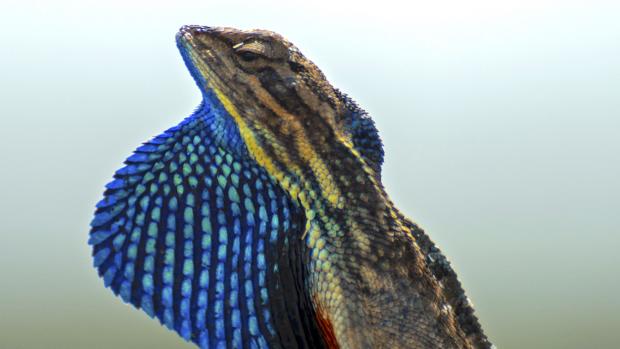
Photo: Maria Thaker
All living things communicate with other individuals in their environment. The communication can be directed to many receivers like, a macaque raising an alarm to broadcast the presence of a tiger, or it can be a specific signal just to a single individual, like a peacock displaying his beautiful plumage for a peahen. Signals in nature often communicate a single message to the receivers. But is it possible for a signal to communicate different messages to different individuals? A team of researchers from the Centre for Ecological Sciences, Indian Institute of Science (IISc), Bangalore, has explored this interesting question in their recent study on superb fan throated lizards (Sarada superba).
The superb fan throated lizards are endemic to the northern, drier parts of the Western Ghats. Male lizards possess a flap of skin under their lower jaw, called the dewlap. Before the mating season, dewlaps start developing bright blue, black and orange coloured patches, which have earned this lizard its name. Females on the other hand, have smaller and white coloured dewlaps, indicating that they are not under as strong a selection to be attractive for sexual or social reasons.
“Superb fan throated lizards probably have one of most conspicuous sexual signals of any lizard in southeast Asia, which makes them a great model taxon to examine signal evolution.”, says Mr. Amod Zambre, one of the authors of the recent paper.
Often, males are seen perched on rocks in open rocky areas, such that their dewlap is visible to all lizards in the surroundings, both of the same and the opposite sex. This behaviour, the researchers say, indicates that male lizards are likely signalling to multiple receivers. Their reproductive success, by finding mates and fending off competitors, depends on successfully communicating this signal. Individuals with traits that can communicate signals effectively are more likely to find mates and pass the genes for these traits to the next generation. Such sexual selection ensures that the traits are maintained in a population. “Our study was designed to examine whether different colours on the male’s dewlaps evolved under different selection pressures to communicate to both females and males”, adds Mr. Zambre.
To conduct their experiments, the team built robots that looked and behaved like male lizards. “Using robots we could systematically manipulate individual components of lizard signals. This would have been super challenging (almost impossible) to do in the field with live lizards”, says Mr. Zambre, emphasising the role of robots in the study, a possible first for studying animal behaviour in India.
During their experiment, the wild lizards were exposed to lizard-like robots from a glass case. Their response to the robots colouration and behaviour was observed using a camera mounted on the glass box. The researchers observed that males and females responded differently to the different colours on the robotic lizard’s dewlaps, giving important clues about the role of colours and the behaviour in social interactions. All individuals were quick to respond to moving dewlaps rather than stationary extended ones, which meant that movement was an effective attractor. But different colours elicited different responses. Females preferred the orange colouration in the dewlap, while males preferred blue and black colours. “Our controlled study tells us that the lizards can perceive all these colours, they just have different preferences. What they pay attention to likely reflects the information that is relevant to them.” says Dr. Maria Thaker, a co-author and Assistant Professor at IISc.
“Orange, blue and black are made in fundamentally different ways in a lizard and thus could convey independent information about health or aggression”, says Dr. Thaker. “For superb fan throated lizard, orange has likely evolved as result of female choice and blue and black due to male-male competition. This might be because male and female lizards may be interested in different types of information about the signalling individual, which could explain the evolution of multicolour dewlaps”, concludes Mr. Zambre. This research is definitely a stepping-stone in not just understanding the behaviour of superb fan throated lizards, a species discovered in 2016, but also why there is such a great diversity of colours and patterns in nature.
Perhaps, the next time you spot a colourful lizard in your garden, maybe you should spare a thought about its possible interesting traits!
